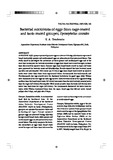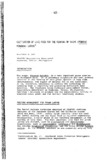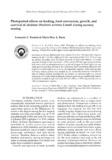Food selection of early grouper, Epinephelus coioides, larvae reared by the semi-intensive method
Share
Abstract
The grouper, Epinephelus coioides, larvae were reared in outdoor tanks with nauplii of copepods and/or rotifers, Brachionus rotundiformis as food. Nauplii propagated in tanks consisted mainly of Pseudodiaptomus annandalei and Acartia tsuensis. Gut content was examined for a total of 953 larvae sampled from day 3 to day 10 (day of hatching being day 0) . Grouper larvae successfully started feeding on early stage nauplii even if their abundance was as low as ca. 100 ind./l and showed better survival and growth thereafter compared to those fed with rotifers only. Feeding incidence reached 100% on day 4 when nauplii were available and only on day 9 when rotifers were given alone. Selective feeding ability of larvae seemed to start from day 4 and the larvae thereafter preferred to feed on medium- and large-size nauplii than rotifers. Coastal calanoid copepods of the genera Pseudodiaptomus and Acartia could be reproduced in tanks and their nauplii can be used as food for marine fish larval rearing.
Suggested Citation
Toledo, J. D., Golez, S. N., Doi, M., & Ohno, A. (1997). Food selection of early grouper, Epinephelus coioides, larvae reared by the semi-intensive method. Suisan Zoshoku , 45(3), 327-337. https://doi.org/10.11233/aquaculturesci1953.45.327
Subject
Collections
- AQD Journal Articles [1248]
Related items
Showing items related by title, author, creator and subject.
-
Bacterial microbiota of eggs from cage-reared and tank-reared grouper, Epinephelus coioides
Tendencia, Eleonor (European Association of Fish Pathologists, 2004)At SEAFDEC AQD, opaque spawned grouper eggs are observed during collection in cage-reared brood stock; while opaque and multi-colored eggs are often observed in tank-reared fishes. This study aimed to investigate the ... -
Cultivation of live feed for the rearing of sugpo (Penaeus monodon) larvae
Yap, Wilfredo G. (European Mariculture Society, 1979)The sugpo, Penaeus monodon, is a very important prawn species in Southeast Asia. It is extremely euryhaline and fast growing. Interest in the farming of this prawn species is very high. Unfortunately, the supply of natural ... -
Photoperiod effects on feeding, food conversion, growth, and survival of abalone (Haliotis asinina Linne) during nursery rearing
Fermin, Armando C.; Buen Shela Mae A. (Phuket Marine Biological Center, 2001)Juveniles of Haliotis asinina, 10 mm shell length were subjected to four photoperiodic regimes namely, 6L:18D, OL:24D, diffused 12:12D, and ambient light (12L:12D) serving as control. Juveniles were fed fresh seaweed, ...




